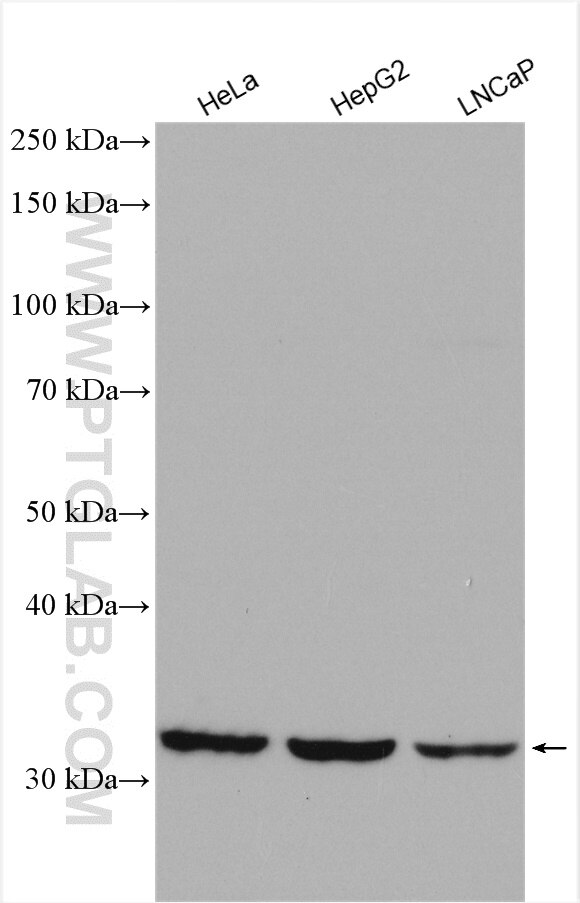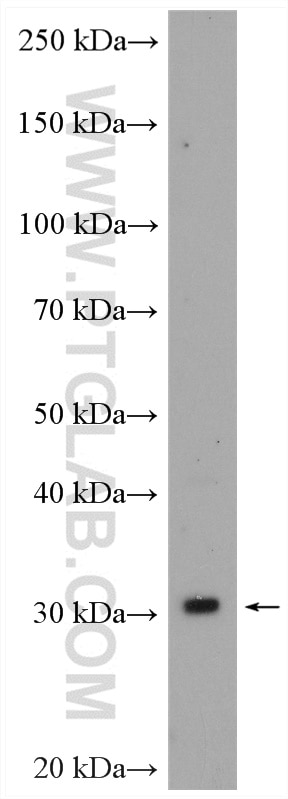Tested Applications
| Positive WB detected in | HeLa cells, HEK-293 cells, HepG2 cells, LNCaP cells |
Recommended dilution
| Application | Dilution |
|---|---|
| Western Blot (WB) | WB : 1:500-1:2000 |
| It is recommended that this reagent should be titrated in each testing system to obtain optimal results. | |
| Sample-dependent, Check data in validation data gallery. | |
Published Applications
| WB | See 1 publications below |
Product Information
26874-1-AP targets SLC35A3 in WB, ELISA applications and shows reactivity with human samples.
| Tested Reactivity | human |
| Cited Reactivity | human |
| Host / Isotype | Rabbit / IgG |
| Class | Polyclonal |
| Type | Antibody |
| Immunogen |
CatNo: Ag25468 Product name: Recombinant human SLC35A3 protein Source: e coli.-derived, PET28a Tag: 6*His Domain: 158-220 aa of BC005136 Sequence: SDSQLDSKELSAGSQFVGLMAVLTACFSSGFAGVYFEKILKETKQSVWIRNIQLVSFSLEPSL Predict reactive species |
| Full Name | solute carrier family 35 (UDP-N-acetylglucosamine (UDP-GlcNAc) transporter), member A3 |
| Calculated Molecular Weight | 325 aa, 36 kDa |
| Observed Molecular Weight | 32-36 and 41 kDa |
| GenBank Accession Number | BC005136 |
| Gene Symbol | SLC35A3 |
| Gene ID (NCBI) | 23443 |
| RRID | AB_2880665 |
| Conjugate | Unconjugated |
| Form | Liquid |
| Purification Method | Antigen affinity purification |
| UNIPROT ID | Q9Y2D2 |
| Storage Buffer | PBS with 0.02% sodium azide and 50% glycerol, pH 7.3. |
| Storage Conditions | Store at -20°C. Stable for one year after shipment. Aliquoting is unnecessary for -20oC storage. 20ul sizes contain 0.1% BSA. |
Background Information
SLC35A3, also named as UDP-N-acetylglucosamine transporter(NGT), is located to the Golgi apparatus. SLC35A3 can form heterologous complexes with SLC35A2(UGT) and Mgats in the Golgi membrane which may promote biosynthesis of complex N-glycans. It has been reported that the mutation of SLC35A3 is associsted with skeletal dysplasia and epilepsies which could result from impaired glycosylation of proteins. SLC35A3 has some isoforms with 32-36 kDa and 41 kDa.(PMID: 25944901, 28777481 , 16344554, 23583405)
Protocols
| Product Specific Protocols | |
|---|---|
| WB protocol for SLC35A3 antibody 26874-1-AP | Download protocol |
| Standard Protocols | |
|---|---|
| Click here to view our Standard Protocols |






